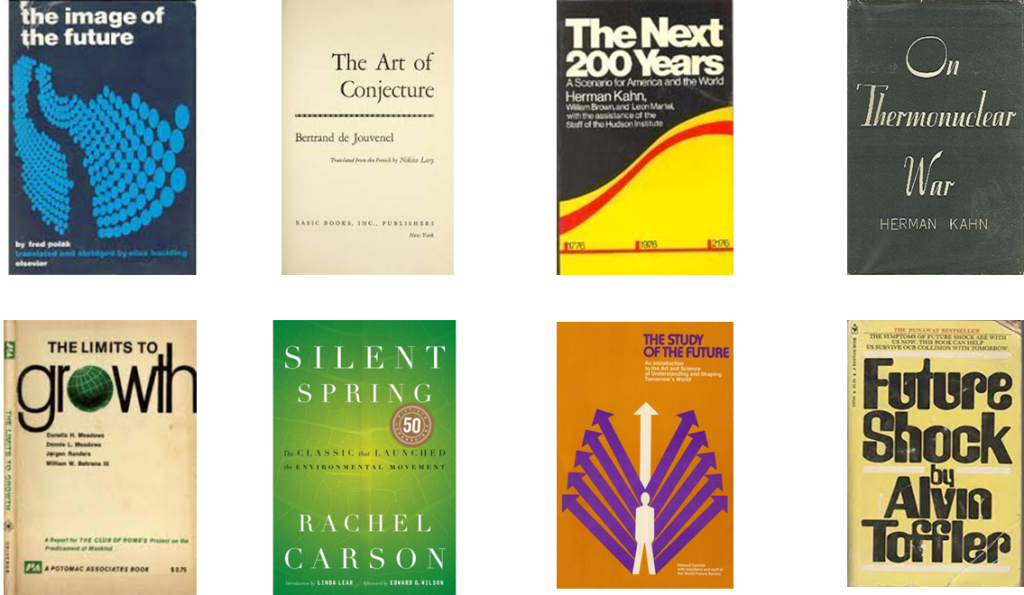The field of modern futurism/futures studies was well known in the 1960s. The publication of Frederick Pollack’s book “The Image of the Future” in 1951 and the publication of “The Art of Conjecture” by Bertrand de Jouvenel in 1964 are one of its hallmarks. Pollack used the concept of the image of the future to analyze the ups and downs of civilizations. He studied ancient civilizations and empires and explained that the main reason for the collapse of these empires (including the Persian and Roman Empires) was the lack of a Image/vision of the future. But Bertrand de Jouvenel first addressed the logical and political problems of forecasting and outlined methods for studying the future of the social, economic, and political spheres. Another influential figure in the growth and development of futures studies was Herman Kahn. Kahn was one of the founders of the Hudson Institute, which was instrumental in the development of the scenario writing method (one of the most widely used futures studies methods). His books “The Next 200 Years”, “On Thermonuclear War”, and “Thinking about the Unthinkable” are some of his books written for the future in the style of scenario writing. Apart from key individuals, the formation of specialized futures research associations was another sign of the emergence of this new discipline. In 1966, for example, the World Future Society was founded by Edward Cornish and others, making it one of the largest and most influential futures research organizations.
In 1967, Aurelio Peccei and others founded the Club of Rome. This small group became one of the most influential futures groups in the 1970s. The Club of Rome rose to prominence in the 1970s due to the publication of the books “The Limits to Growth” and “Silent Spring”, and the theories presented in this club led to protest and social movements such as the Gaia movement to preserve and save the environment. The publication of the book “Future Shock” by Alvin Toffler in the early 1970s was also very effective in introducing the subject of futures studies to people and the development of the field of futures Studies. In the 1970s, Daniel Bell, a prominent futurist and sociologist, spoke of the advent of post-industrial society. He stressed that the industrial society is based on machine technology, while the formation of a post-industrial society is based on software, and coded knowledge. In Daniel Bell’s view, the main structural features of industrial society were labor and capital. But in a post-industrial society, information and knowledge are the main characteristics. In 1977, the World Future Society published “The Study of the Future” by Edward Cornish. Cornish was able to report on the vast research he had done on futures studies and identify growing associations with futures studies. Another person who I think has played an important role in the development of futures studies in the social sphere is Oliver Markley. His book, “Changing Images of Man”, published in collaboration with the Stanford Research Institute in 1982, is one of the most influential books on futures studies.
A short and comprehensive history cannot be written for the field of future studies, because the field of contemporary future studies has gone through various evolutionary paths. One of these paths was based on the work of William Ogburn and his colleagues, based on the analysis of social trends and the role of technology in social change. One of the achievements of him and his colleagues was the emergence of a discipline now called “technology evaluation”.
Another path in the evolution of futures studies was “operations research” and the think tanks. In 1945, General Henry H. Arnold established a research institute called “Rand Corporation” to provide intellectual assistance to the US Air Force in its decisions. This institute is one of the most effective and influential institutions and organizations that do intellectual work. Most of the Rand’s achievements, such as the selection of policies, strategies, recommendations, early warnings, long-term plans, forecasts and new ideas, in some way involve forward-thinking thinking and are implemented by US governments. Since the 1970s, the RAND Corporation has added some civilian projects to its activities, and has since declassified them. Today, there are many institutions in the private sector or in government structures around the world whose main task and mission is to monitor current and future developments and trends helping companies, organizations and governments in sensitive and long-term decisions that they have to make.

 فارسی
فارسی
